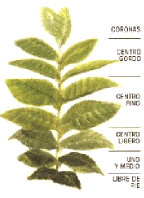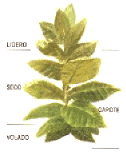|
 |
|
| Habanos : the underlying history |
|
 History History |
| Tobacco's culture has probably
began on the American continent, most likely in Mexico since tobacco
was already known by the Mayas. |
| After
Christopher Columbus' journey in 1492, the rest of the world was
discovering tobacco. Afterwards, Spanish and Portugese sailors
brought back to Europe tobacco, which started to be popular. |
|
 The origin of the word
"tobacco" The origin of the word
"tobacco" |
| We
can possibly imagine that the word tobacco comes from the island
of Tobago in the Carribbean. Other sources indicate that the origin
of this word comes from the Tabasco state in Mexico. As for the
word "cigar", it derives from "sikar" which means "to smoke"
in the Mayas language. |
|
 The
production The
production |
| The
first European cigars were manufactured in Spain (Seville)
beginning in 1717. At the beginning of the 19th century, the
spanish cigars were replaced by cuban cigars because of their
better quality. |
| In
Cuba, tabacco production has existed since the beginning of the
16th century. In the middle of the 19th century, there were 9'500
tobacco plantations and about 1'300 manufacturers. This number was
reduced to 120 around the start of the 20th century. |
|
 Facts
about cigars Facts
about cigars |
| 1.
Five
types of leaves are required to make a Habano. |
| 2.
“The
Tripa” or core of the cigar contains a mixture of 3 leaves : Ligero,
Seco and Volado.
|
| 3.
These
are wrapped by the undercoat, “La Capote”, whereas the outer layer,
“La Capa”, covers the cigar to give it its appearance.
|
| 4.
There
are two varieties of seed, each of which produces a different tobacco
plant : “Corojo” and “Criollo”. |
|
|
|

Corojo
|
|

Criollo
|
|
|

|
|